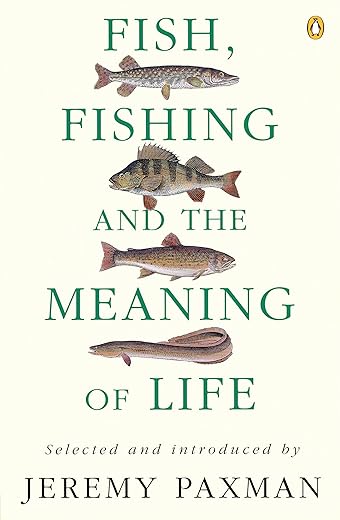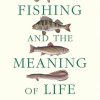Fish, Fishing and the Meaning of Life
£12.30£14.20 (-13%)
In Fish, Fishing and the Meaning of Life Jeremy Paxman creates the perfect literary catch for fellow angling enthusiasts in this rich and varied anthology.
‘A superb compilation because it roams from carp to cod, trout to tarpon and does not regurgitate the same old clippings’ Independent on Sunday.
Each chapter is introduced by Paxman’s own sharp, humorous observations and features both contemporary and historical writing about fishing in prose and verse, covering everything from tench tickling to piranha attacks. Some pieces are well known favourites, others are obscure, every one is a delight.
Jeremy Paxman is a journalist, best known for his work presenting Newsnight and University Challenge. His books include Empire, On Royalty, The English and The Political Animal. He lives in Oxfordshire.
Read more
Additional information
| Publisher | New Edition (2 Nov. 1995), Penguin |
|---|---|
| Language | English |
| Paperback | 576 pages |
| ISBN-10 | 0140237410 |
| ISBN-13 | 978-0140237412 |
| Dimensions | 12.9 x 2.4 x 19.8 cm |












by Stephen Hood
Thought it was about Jeremy Paxmans fishing stories. So my mistake. Although there where a good few tales from across the ages.
by Amazon Customer
At 500+ pages this is not a book to read from cover to cover over a few days. JP has collected hundreds of fishing stories from way back to the 1990’s when this book was published, and categorised them into chapters with a common theme, providing a short introduction for each chapter.
No piece is more than two or three pages so this is a booked to be dipped into quite easily.
Personally, I found the pieces from the 20th century more interesting I.e. Sheringham, bb, Walker but each to their own.
Worth buying even if some of the pieces are not to your taste.
by Ralph Blumenau
Five lyrical pages about fishing in Jeremy Paxman’s “A Life in Questions” (see my Amazon review) led me, although I am not a fisherman, to get this anthology compiled by him – all 540 pages of it, of quite small print, with a bibliography running to more than 8 pages. Each of its ten chapters has a short introduction by Paxman, and these are beautifully written. And in many of the pieces he has selected there is also some lovely writing.
I suppose a lover of fishing can never have enough of pieces describing its joys and thrills; but there is a certain sameness between many of the extracts within several of the chapters. In the first, “Idylls”, the writers convey the beauty of getting away from it all, and the way the fisherman is at one with nature and aware not only of the fish and the water, but also of other aquatic creatures, of the birds, of the trees and plant-life on the river-banks, of the light, and of the satisfaction felt at the end of the day. Many of them describe the thrill of playing and landing a fish and how, out of season, the angler dreams of the next one and lovingly puts together the flies for when fishing can resume. When they describe the flies, they rarely mention the hooks underneath them, and they do not refer to the suffering of the fish.
In his introduction to the last chapter, “The Ethics of Fishing”, Paxman pours scorn on “the little band of fanatics … who cannot bear the thought that people are enjoying themselves”; he denies that “fish feel pain like any warm-blooded creature” (which is the case made by some scientists, though others reject it), and he even implies that in any case the fish has it coming to it because it dies “as a consequence of its own greed, hunger or aggression … The fish has free choice.” As opposed to killing thousands of fish caught in trawler nets, catching and killing individual fish by angling and gaffing is a noble activity: honourable single combat instead of mass slaughter. There are several pieces in this chapter saying similar things, though it also quotes Lord Byron’s opinion that fishing involves so much cruelty that “no angler can be a good man”.
But the book conveys very well and engagingly what attracts so many thousands of people to the sport. The chapter on “Fish” records many stories about and observations of various species. We read about wondrous fish like the small Alaskan Dallia Pectoralis and the mighty Mahseer of India (look them up on Google Images). I particularly liked the sermon that St Anthony is said to have preached to fishes; the story of a frog getting the better of that savage creature, a pike; and of what brandy can do to a carp that seems to have died.
The chapter on “Tactics” tells you of the remarkable and risky way the Gilbertese bait an octopus; and there are accounts of fishing with spears, harpoons, gaffs, arrows, leisters (look them up on Google Images – I would have appreciated a Glossary), baits of dry fly, wet fly (looked down upon by many dry fly anglers), live frogs (ugh!), hooks attached to geese (!), or by hand (trout tickling).
The chapter on “Rods, Reels and Bottles of Gin” contains pieces of often amusing advice not only on fishing tackle, but on the clothes to wear and on what other things, from frying pans to tobacco and alcohol, that will sustain the angler. There is a pleasure in buying tackle and bait from a specialist shop, but there is also advice on how to make your own.
Then there is a chapter about the “Ones that Got Away”, often after a long struggle (ten hours in one instance), remembered and recalled in great detail, and about the emotions felt by the angler if the fish are – as they usually are – of exceptional size. No tall tales, as far as I can make out. (There are some nice tall tales in the last chapter.) This particular chapter ends with a great whale – admittedly not a fish – that got away, and the next one, on the “Ones that Didn’t Get Away”, begins with the whale that inspired “Moby Dick” being slain. Again we have many a titanic struggle, and this time the feelings of triumph.
The next two chapters are about “The Dangers of Fishing”. The first of them is about the angler damaging himself, or losing his footing on a bank or when wading in fast-flowing streams; there are encounters with bulls and cows, with wasps, horse-flies, midges, ants and adders; and there are some humorous and self-deprecating accounts of various kinds of mishaps. An obsession with fishing may even imperil a marriage.
The next chapter, about “Fish that Bit Back” has nothing amusing about it: it is about some fish which can inflict severe damage and worse. Some have fearsome teeth – even rows of them. Some have venomous spines: if you step on a stone fish lying among rocks, its poison will kill you. There are accounts of the ferocious piranha which can amputate fingers or toes and strip the flesh off a drowned man; barracuda; shark – in New Jersey in 1916 one killer shark took nine men or boys in ten days, some in a creek 20 miles inland from the ocean; swordfish which can pierce the hull of a boat. There is a story of a man being swallowed whole by a sperm whale which was soon afterwards killed and cut open – he was still alive and made a full recovery.
Among Paxman’s most evocative introductions – and also, at six pages, the longest – is the one to the chapter on “Fishing Inns and Fishing Accomplices”, and, to my mind, it is actually better than most of the pieces he has selected.
And so back to that last chapter on Ethics. Several pieces in this selection are devoted to the human qualities and temperaments that make for a good fisherman. A writer of 1845 says that he has “almost invariably found [anglers] persons of good and charitable dispositions”. Properly conducted, fishing, says a text of 1496, is “good for the health of your body and specially of your soul”. In 1933 one writer said that “angling is like playing tennis with God.” Some make much of the fact that there were several fishermen among Christ’ disciples.
I am not sure what Paxman means by “The Meaning of Life”. Does it lie in the feeling that devotees have, that fishing makes them part of nature? Or in the ancient struggle between not too ill-matched creatures, Man and powerful fish? Or in the qualities and temperaments that make for a good fisherman which also make, according to the lovers of the sport, for men of “good and charitable dispositions”? Or does it simply mean that, for the passionate fisherman, fishing gives his life more meaning than any other activity?
by Mr. W. Nicol
A really diverse and interesting look at angling’s allure. The book contains a vast selection of short descriptive passages which cover all aspects from idyllic surroundings, the appreciation of fishing skills, and many stories which detail the fascinating exploits of anglers from across the ages. Recommended for anyone with a broader interest in fishing than simply standing at the water’s adge.
by JPL
I like that you can dip in and out of this book. Some amusing anecdotes from contemporary times to our forefathers. Some of the tales are longer than others! No doubt there is some comparison to be had between the patience and skill to navigate tackle and bait and those other parts of our life throw up.
by scotsandy
Bought this as a gift for my husband who is a keen fisherman. Thought he would enjoy this written by Jeremy Paxman as he likes to watch him when he’s on TV. My husband always has several books on the go at one time so found he could slot parts of this in between other reads.
by Amazon Customer
Some of this book is poetic, atmospheric and idyllic. It gives a true portrayal of the angler’s character and is very pleasant to read.
by Longtrotter
Wow, what a great anthology!I’ll begin by making the obvious comparison. The comparator, of course, being BB’s Fisherman’s Bedside Book which is an anthology of similar length and scope. Waterlog once described BB’s book as ‘The Best Fishing Book in the World’. I have to conclude that the author of that claim hadn’t read ‘Fish, Fishing and the Meaning of Life’.
This collection is quite simply MAGNIFICENT! Paxman has left no stone unturned in putting together a delightful collection of angling writing. He states in his introduction that a search for ‘fish’ and ‘fishing’ on the British Library database brings up 6803 books and then gives the impression of having read every one of them in putting this volume together. There are collected here, over 300 articles from over 250 books by over 200 authors, spanning the last 2000 years.
Paxman has cast his net further and wider than BB and has included contributions from many more authors. Of course there’s an extra 40 years worth of literature to choose from and much of the selection from this period is from across the Atlantic with some great choices from authors such as Zane Grey, Gierach and Zern. Meanwhile the likes of Dick Walker and Chris Yates, amongst others, help keep the British ‘end up’. There is also space to ‘correct’ some of BB’s ‘glaring omissions’ – Fish, Fishing and the Meaning of Life has contributions for The Trent Otter and John Bickerdyke for example, two authors overlooked in The Fisherman’s Bedside Book. Don’t get me wrong, The Fisherman’s Bedside Book IS an excellent read and it just goes to show what a superb job Jeremy Paxman has done in bettering it.
But, of course, it’s not just about the authors chosen it’s about the works selected. And the ones picked by Paxman are truly excellent. He has assembled his choices under 10 themes, with headings such as Rods’ Reels and Bottles of Gin, Ones That Got Away and Fish That Bite Back. Each chapter is introduced by an essay from Paxman which shows he’s also a dab hand when it comes to turning out a well chosen word or two.
There is much in this compilation which conveys a wry humour and there are even flashes of Paxman’s famous sarcastic wit. This is very evident by the titles he gives to some of the articles – here’s an example of three of them…”Pliny’s Belief in the Extraordinary Power of a Two-Inch Sea-Gudgeon.”, “G.E.M. Skues Meets Frederick Halford, High Priest of the Dry Fly, and is Less Than Impressed.” & “Captain Mainwaring Praises Dynamite”. All very droll!
Prose, verse, extracts from angling catalogues (Hardy’s of course), Letters to The Field, newspaper articles; If the writing is particularly fine – or reveals some angling curiosity it gets included. (I particularly enjoy the sprinkling of ‘Letters to the Editor’ which appear throughout the book) The collection is singular and unique with very little here that I have read in other anthologies. It is a real treasury. Jeremy Paxman deserves a Knighthood for ‘Services to Angling’ for putting together this cornucopia.
This book would definitely be my one obligatory choice should I ever be stranded on that desert island! And if you want some ideas on what classic angling books to read this book seems the ideal starting point to give you some inspiration.
“Those dappled sunlit days introduced me to a world I would never otherwise have known. When the loudest sound was the babbling river, creatures went about their lives undisturbed. Grey and yellow wagtails bucked their way across the rocks. Water rats would drop into pools with a ‘plop’. Otters would glide noiselessly in and out of the water. One time an eel slithered across the toes of my boots. Sandpipers called ‘twee-wee-wee’ as they flew over the water, and, where the river had cut high banks in the soft earth, sand-martins popped in and out of their honeycombed colonies. Then from nowhere, the air would be split by a flash of sapphire, as a kingfisher tore down the river, six feet or so above the water. As evening fell and as more and more flies hatched on the water surface, swifts flew tireless aerobatics.” From The Introduction.
“From this brief digest, then, the following rules seem sensible: If you haul into the boat anything long and snake like, kill it at once or throw it back over the side.
Don’t wear anything silvery while wading in barracuda territory – you might get mistaken for a fish.
Don’t wade in bear feet on coral.
Don’t hunt whales. But if you get swallowed by a whale, at all events keep calm and prepare yourself for a new career as a snowman (see page 410).
If your fishing in the Amazon, don’t pee in the water.”
From the Introduction to Fish That Bite Back, both by Jeremy Paxman